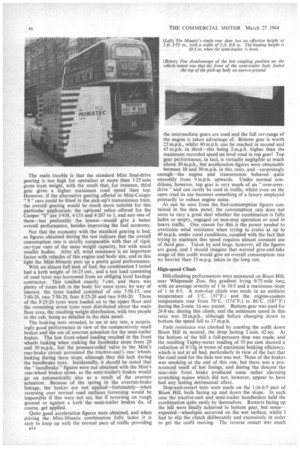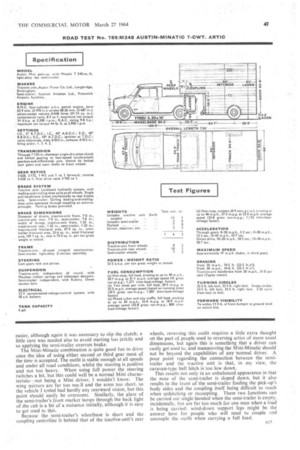This Artic Makes 'em Stop and Stare
Page 47

Page 48

Page 49

If you've noticed an error in this article please click here to report it so we can fix it.
By John F. Moon
A.IVI.I.R.T.E.
ROAD TEST: Austin-Minatic 7-cwt. artic ICANNOT think of any other commercial vehicle that I have tested in recent years which has attracted more positive interest than the Austin-Minatic 7-cwt. articulated van that I put through its paces recently: it eventually got to the stage that whenever I stopped the vehicle in traffic or at the kerb I was prepared for someone to ask me what it was and where he could buy one. Shoe salesmen, wanting something like the Minatic to carry their samples around in; caterers, needing the Minatit's capacity to convey folding tables and so forth to various functions; street-market traders, looking upon it as an ideal portable stall; house decorators,quick to see the possibility of carrying ladders and other light but bulky commodities from place to place, and also using the semi-trailer as a portable " canteen " for their men to feed and rest in; potato-crisp carriers, ' who really need space without the weight-carrying capacity. The list is endless, and it made me realize that the sales of the Minatic promise to be pretty high. And following my road test of one, I am perhaps in a better position than most people to say this.
The Minatic range was fully described in our March 6 issue, and the example I tested was the smallest model—the Minatic 7—which has a 240-cu.ft. body and has been designed for use in conjunction with Austin and Morris Mini pick-ups. The Minatic is the brain-child of Mr. K. E. M. Kaye, and is the joint production of Highland Engineering Ltd., 11 Castle Street, Edinburgh, 2, and Scottish Aviation Ltd., Prestwick Airport, Ayrshire, sales being handled through the latter address.
The economics of the Minatic 7 for those requiring a large, enclosed payload space, without a particularly high payload-weight rating are fairly obvious. To begin with, the Minatic 7 semi-trailer is priced at the rate of £1 per cu. ft., so its cost is £240,.this including the towing attachment bolted to the sides of the standard B.M.C. Mini pick-up, the price of the pick-up itself being listed as £369 10s.; the total of £609 10s, is something like £100 less than the price of a typical rigid van of the same size.
Despite—by normal British delivery-vehicle standards— being underpowered, the Mini-Minatic combination is quite economical on fuel, whilst many operators should be able to make use of a further advantage in that by removino° the four bolts which secure the coupling attachment, the Mini can be used as a perfectly standard pick-up, thus giving two vehicles for less than the price of one. My only fear about the combination is as to whether the engine and transmission line will be able to stand up to prolonged operation while carrying the full nominal payload, although on the credit side it must be realized that few potential operators of this machine will expect it to carry a full payload all its life—it suggests itself as being more likely to be used on reducing-payload operations. The main trouble is that the standard Mini final-drive gearing is too high for operation at more than 1-25 tons gross train weight, with the result that, for instance, third gear gives a higher maximum road speed than top. However, if the alternative gearing offered in Mini-Cooper " S " cars could be fitted in the pick-up's transmission train, the overall gearing would be much more suitable for this particular application: the optional ratios offered for the Cooper "S" are 3-938, 4.133 and 4-267 to 1, and any one of these—but preferably the lowest—would give a better overall performance, besides improving the fuel economy.
Not that the economy with the standard gearing is bad, as figures obtained during the test indicate that the overall consumption rate is strictly comparable with that of rigid, car-type vans of the same weight capacity, but with much smaller bodies. After ail, wind resistance is an important factor with vehicles of this engine and body size, and in this light the Mini-Minatic puts up a pretty good performance. With an almost full tank of fuel, the combination I tested had a kerb weight of 16-25 cwt., and a test load consisting of used tyres was borrowed from an obliging local haulage contractor. This totalled exactly 7 cwt. and there was plenty of room left in the body for more tyres: by way of interest, the tyres loaded consisted of one 7-50-15, one 7.00-20, two 7-50-20, four 8-25-20 and two 9-00-20. Three of the 8.25-20 tyres were loaded on to the upper floor and the remaining seven tyres were distributed about the main floor area, the resulting weight distribution, with two people in the cab, being as detailed in the data panel.
The braking tests revealed, to me at any rate, a surprisingly good performance in view of the comparatively small brakes and the use of overrun actuation for the semi-trailer brakes. The low front-wheel loading resulted in the front wheels locking when making the footbrake stops from 20 and 30 m.p.h., but the pressure-relief valve in the Mini's rear-brake circuit prevented the tractive-unit's rear wheels locking during these stops, although they did lock during the handbrake tests. Incidentally, it should be noted that the " handbrake" figures were not obtained with the Mini's rear-wheel brakes alone, as the semi-trailer's brakes would go on automatically also as a result of the overrun actuation. Because of the spring in the overrun-brake linkage, the brakes are not applied—fortunately—when reversing over normal road surfaces (reversing would be impossible if this were not so), but if reversing on rough ground or against a kerb the semi-trailer brakes do, of course, get applied.
Quite good acceleration figures were obtained, and when driving the Mini-Minatic combination fully laden it is easy to keep up with the normal pace of traffic providing a14
the intermediate gears are used and the full rev-range of the engine is taken advantage of. Bottom gear is worth 25 m.p.h., whilst 40 m.p.h. can be reached in Second and 47 m.p.h. in third—this being 2 m.p.h. higher than the maximum recorded speed on level road in top gear! Top gear performance, in fact, is virtually negligible at much above 30 m.p.h., but acceleration figures were obtainable between 10 and 30 m.p.h. in this ratio, and—surprisingly enough—the engine and transmission behaved quite smoothly from 9 m.p.h. upwards. Under normal conditions, however, top gear is very much of an " over-overdrive " and can rarely be used in traffic, whilst even on the open road its use becomes something of a luxury employed primarily to reduce engine noise.
As can be seen from the fuel-consumption figures contained in the data panel, the consumption rate does not seem to vary a great deal whether the combination is fully laden or empty, engaged on non-stop operation or used in heavy traffic. One reason for this is the power needed to overcome wind resistance when trying to cruise at up to 40 m.p.h. under rural conditions, coupled with the fact that trying to maintain this speed requires almost constant use of third gear. Taken by and large, however, all the figures are good, and I should imagine that normal give-and-take usage of this outfit would give an overall consumption rate no heavier than 35 m.p.g. taken in the long run.
High-speed Climb Hill-climbing performances were measured on Bison Hill, near Whipsnade Zoo, this gradient bring 0.75 mile long with an average severity of 1 in 10-5 and a maximum slope of 1 in 6.5. A non-stop climb was made in an ambient temperature of 3°C. (37°F.) and the engine-coolant temperature rose from 79°C. (I74°F.) to 86°C. (187°F.)
• during the 2-min. 16-sec. ascent. Bottom gear was used for 26-8 sec. during this climb, and the minimum speed in this ratio was 20 m.p.h., although before changing down to bottom the speed fell to 17 m.p.h.
Fade resistance was checked by coasting the outfit down Bison Hill in neutral, the drop lasting 2 min. 42 sec. At the bottom of the hill a full-pressure stop was made, and the resulting Tapley-meter reading of 55 per cent showed a reduction of 0.15g in terms of maximum braking efficiency, which is not at all bad, particularly in view of the fact that the road used for the fade test was wet. None of the brakes was smoking at the end of this run, but there was a pronounced smell of hot linings, and during the descent the near-side front brake produced some rather alarming scratching noises which did not, however, appear to have had any lasting detrimental effect.
Stop-and-restart tests were made on the 1-in-6.5 part of Bison Hill, both facing up and down the slope. In each case the tractive-unit and semi-trailer handbrakes held the combination quite easily by themselves. Restarts facing up the hill were finally achieved in bottom gear, but someexpected—wheelspin occurred on the wet surface, whilst I had to slip the clutch deliberately and excessively in order to get the outfit moving. The reverse restart was much
easier, although again it was necessary to slip the clutch; a little care was needed also to avoid starting too jerkily and so applying the semi-trailer overrun brake.
The Mini-Minatic combination is quite good fun to drive once the idea of using either second or third gear most of the time is accepted. The outfit is stable enough at all speeds and under all road conditions, whilst the steering is positive and not too heavy. When using full power, the steering twitches a bit, but this could well be a normal Mini characteristic-not being a Mini driver, I wouldn't know. The wing mirrors arc far too smtil and the arms too short, so the vehicle tested had hardly any rearward vision, but this point should easily be overcome. Similarly, the glare of the semi-trailer's front marker lamps through the back light of the cab is a bit of a nuisance initially, although it is easy to get used to this. Because the semi-trailer's wheelbase is short and the coupling centreline is behind that of the tractive-unit's rear wheels, reversing this outfit requires a little extra thought on the part of people used to reversing artics of more usual dimensions, but again this is something that a driver can easily get used to, and manceuvring the Mini-Minatic should not be beyond the capabilities of any 'normal driver. A poor point regarding the connection between the semitrailer and the tractive unit is that, in my view, the caravan-type ball hitch is too lOw down.
This results not only in an unbalanced appearance in that the nose of the semi-trailer is sloped down, but it also results in the front of the semi-trailer fouling the pick-up's body sides and the coupling itself being difficult to reach when unhitching or recoupling. These two functions can be carried out single-handed when the semi-trailer is empty, incidentally, but are far too much for one man when a load is being carried: wind-down support legs might be the answer here for people who will need to couple and uncouple the outfit when carrying a full load.




































































































